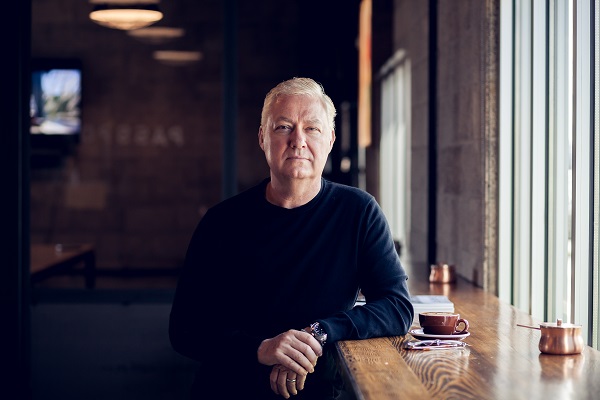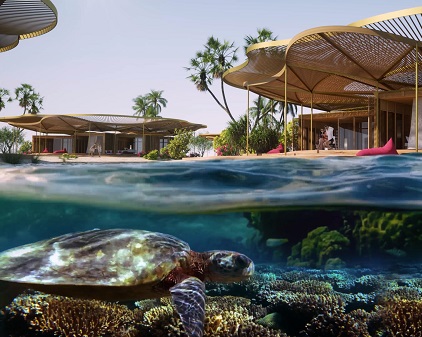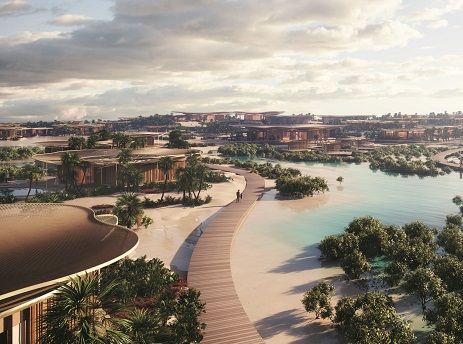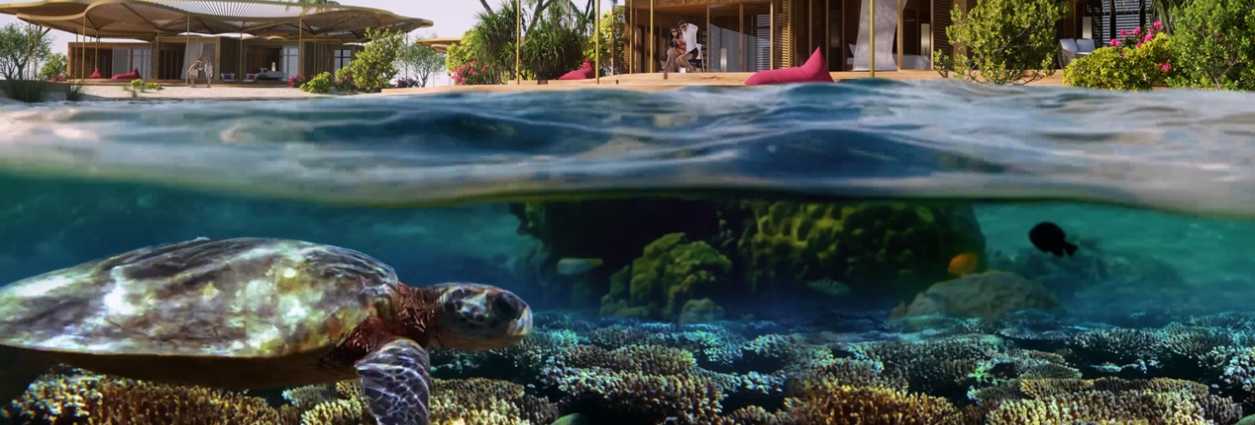Nick King: Nature is what sets Red Sea Project apart
By Olga_Gafurova Monday, 04 October 2021 6:02 PM

The Red Sea Project is taking shape as a rare and unique destination, built around a largely undiscovered, unspoiled environment. It comprises an archipelago of more than 90 untouched islands, sweeping desert dunes, mountain canyons and dormant volcanoes. This incredible, natural terrain provided us with the perfect backdrop for one of the most technologically advanced and eco-friendly tourism destinations in the world, enabling us to set new standards on two innovative approaches: barefoot luxury and regenerative tourism. Nick King, Chief Development Officer of The Red Sea Development Company told to Aviamost how the Red Sea Project relies on innovative technologies to achieve its ambitious sustainability goals.
The Red Sea Project is the world's most ambitious and exciting barefoot-luxury destination underpinned by sustainable development goals. What makes it so unique for travelers?
In essence, nature is what sets us apart. The destination is redefining the barefoot luxury experience at a time when travelers are eager to break free from extended periods of lockdown and reconnect with nature. We are creating an environment where they can witness pristine nature in all its glory. Unparalleled experiences, multiple and unique trail networks and delicately selected dive sites will be packaged together with the highest standard of personalized luxury.
We will also curate authentic and bespoke experiences that celebrate the culture and heritage of Saudi Arabia. Visitors will have a wealth of opportunities to explore the history of the region and experience the warm hospitality and fascinating culture of the local people – from walking in the footsteps of the ancient traders to exploring underwater shipwrecks, and even visiting the relics left behind in sites such as the Nabatean City of Mada’in Saleh, a United Nations Educational, Scientific and Cultural Organization (UNESCO) World Heritage site situated a short distance away.

At the same time, we remain committed to sustainability across every element of the destination. Our unique approach to regenerative tourism means going beyond just protecting the environment to actively enhancing it. The approach involves looking at new ways in which the environment can be improved and encouraged to thrive. As a result, we are aiming for a 30% net conservation benefit by 2040 so that this area of extraordinary natural beauty and diversity can be enjoyed for generations to come. Travelers will find satisfaction in knowing their visit will help protect the area’s extraordinary natural beauty.
Tourism development is a key target for Saudi Arabia’s Vision 2030. How is this project leading KSA’s efforts to welcome a new breed of international travelers and regenerate the tourism industry?
The Red Sea Project is setting out to become the world’s most ambitious tourism development, offering exclusive, unparalleled diversity for discerning global travelers and ultimately helping position Saudi Arabia on the global tourism map. This achievement will be a key contributor to the successful delivery of Vision 2030, a strategic plan that is placing great importance on diversifying the country’s economy.
The destination will be equally instrumental in driving economic growth and job creation in the Kingdom. By current predictions, the contribution of tourism to the GDP of Saudi Arabia will be closer to the global average of 10% by 2030, compared to the 3.4% it represents now. The destination is set to contribute SAR 22 billion ($5.8bn) to the Kingdom’s GDP from 2030 onwards and will also employ around 70,000 people either directly, indirectly or induced. More than 500 contracts worth a collective 16 billion riyals ($4.2bn) have already been awarded, with 70% of the total value signed by Saudi companies.
How has the pandemic impacted the project?
Throughout the pandemic, our priority was the health and safety of our employees. We were able to safely maintain 40% of our workforce on-site. To ensure that everyone had enough space to socially distance, we moved a proportion of workers to temporary accommodation outside of our Construction Village, including four local schools.
Despite this impact, the project has made significant progress on the ground and remain on track to welcome our first guests by the end of next year. In early 2020, we completed the build of our Landscape Nursery, the largest in the region, set to open in early 2020. In addition, we also completed the construction of a Waste Management Facility, opening earlier this year, along with our Construction Village for 10,000 workers and 80km of new roads to better connect the destination. We now have nearly 8,000 staff working safely and securely on-site and recently laid the first asphalt on the runway at the Red Sea International Airport.

Please tell us more about how the project is setting new standards in sustainable development, such as the usage of renewable energy.
Setting new standards in sustainable development requires us to proactively address the challenges of climate change, biodiversity loss, and land degradation. These global challenges present us with a unique opportunity to set new benchmarks in sustainability and become a pioneer in advancing regenerative tourism.
Our main driver is conserving and enhancing nature and biodiversity. Recognizing that these are our most valuable assets, 75% of the destination’s islands will remain undeveloped and nine islands have been designated as protected areas.
We have also made a commitment to carbon neutrality and as such, decided to have no connection to the national grid. This means that the destination will be powered by 100% renewable energy, enabled by the build of the world’s largest battery storage facility in the world. With a capacity of 1000MWh, it will help us save nearly half a million tons in CO2 emissions each year and firmly place us at the forefront of the global transition towards carbon neutrality.
What are the various smart technologies that will help bring the project to life?
The Red Sea Project will be a smart destination underpinned by an extensive range of interconnected smart services, integrated through a Smart Destination Platform. Our 52 smart services will be focused on three pillars: enabling a thriving community, pushing the boundaries of sustainability, and enhancing the pristine archipelago.
The smart services will be interlinked and integrated with a unified user experience, easing our operations across tourism, environment, mobility, utilities, buildings, administration, security, public realm, retail, logistics, healthcare and education. The aim is to enable a personalized visitor journey with a frictionless arrival and departure process, effective management of assets and facilities, fully integrated security and site operations, cashless payments, and touch free experiences.
For example, visitors will be able to digitally explore the destination even before they arrive via augmented reality and virtual reality tour guide technologies. Meanwhile, our smart luggage management system will enable guests to track their luggage in real-time as it is seamlessly transferred to their room. We are also investigating the use of wearable technologies, replacing conventional plastic cards to access hotel rooms and even enabling guests to pay for food and beverages throughout the destination.
Our smart technologies will also help us achieve and track our climate commitments. In addition to the Marine Spatial Planning (MSP) exercise that informed our destination planning strategy, we are also working on implementing new technologies to help us reduce our overall carbon footprint – from 3D coral printing and coral farming processes, to innovative carbon sequestration techniques. Part of our environmental enhancement aim will also be achieved by deploying around 2,500 Internet of Things (IoT) sensors throughout the coral reefs, lagoons, turtle nesting sites and to monitor water usage in irrigation systems.
Red Sea is one of the most significant places on Earth for oceanography and research. What is this project setting out to achieve?
The Red Sea’s vibrant marine life is undoubtedly the cornerstone of our destination. As we invite our guests to explore these wonders of nature, it is equally imperative for us to protect, restore and actively enhance the biodiversity of our marine natural capital.
Before we completed our master plan, we worked closely with the King Abdullah University of Science and Technology (KAUST) on a thorough Marine Spatial Planning exercise to identify areas requiring conservation and protection, and other areas suitable for sensitive and appropriate development. As a result, we are committing to conserve 58% of the marine area of the site, with the development footprint of the total 28,000 sq. km. destination being less than 1% of the total area.
We are also preparing a comprehensive plan to enhance coral reefs, which includes the creation of multiple coral nurseries to interbreed corals with different degrees of tolerance for temperature.
Additional measures include beach cleaning campaigns, the regulation of fisheries to rebuild fish stocks, the expansion of biologically diverse habitats, such as mangroves, seagrass, coral reefs, and land vegetation by 30%, and the use of electric-only marine and land vehicles to avoid pollution and noise.
Our magazine targets Russian and CIS markets. What kind of marketing strategies are you implementing to reach those markets?
As we move into a post-COVID world and prepare to welcome our first guests by the end of 2022, we are greatly encouraged by the pace of recovery in the global travel ecosystem. We are seeing strong industry appetite from markets like Russia and CIS for Saudi Arabia’s growing tourism credentials. It is imperative for us that we capitalize on this momentum through constant dialogue with stakeholders and partners – be it across travel trade or with key media contacts.
Russian tourists already frequent the GCC, representing one of the top 10 source markets for the UAE, with more than 680,000 visitors expected annually by 2023. This represents a compound annual growth rate of 4.2 percent, according to a report by Colliers International in 2020. Saudi Arabia is expected to witness the second largest increase, with total Russian tourism spend estimated to reach $28,659,600 respectively by 2023, with the attraction of destinations like ours that cater to the luxury segment of the tourism market, targeting high-net-worth individuals. Russia is currently ranked fourth in the world in terms of the number of billionaires residing in the country, with 303 Russians representing a total billionaire wealth of $355 billion.
To this end, we are gearing up to accelerate our destination marketing towards the end of this year. Our primary activations will be driven by language-specific channels to ensure greater ease of accessibility for Russian audiences, while ongoing discussions will explore even closer collaborations to showcase the diversity of The Red Sea Project’s offerings. These stakeholder engagements will not only be aimed at further enhancing relationships with in-market partners but also ensure they are well aligned with Saudi Arabia’s wider diversification strategies in line with Vision 2030.





























Add new comment